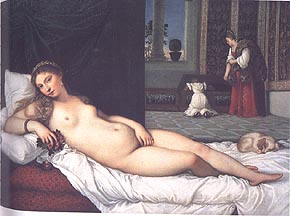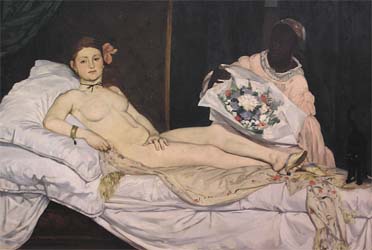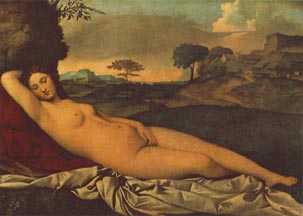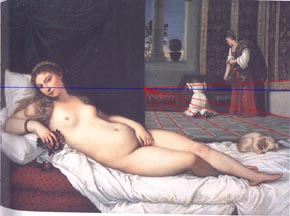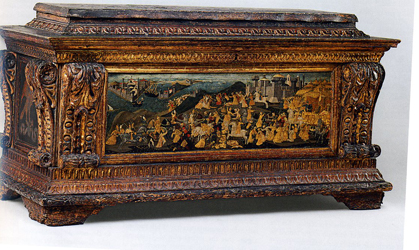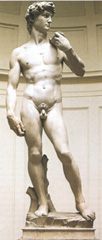Art Home | ARTH Courses | ARTH 200 Assignments | ARTH 213 Assignments
Titian's Venus of Urbino
In March of 1538, Guidobaldo della Rovere, who would become the Duke of Urbino, wrote to his agent in Venice about a painting by Titian he wanted to acquire. He refers to the painting as la donna nuda (the nude woman). This work has been identified as the Venus of Urbino.
Mark Twain, in his Tramp Abroad, recorded his response to his encounter with the Titian's Venus of Urbino:
| You enter [the Uffizi] and proceed to that most-visited little gallery that exists in the world --the Tribune-- and there, against the wall, without obstructing rap or leaf, you may look your fill upon the foulest, the vilest, the obscenest picture the world possesses -- Titian's Venus. It isn't that she is naked and stretched out on a bed --no, it is the attitude of one of her arms and hand. If I ventured to describe that attitude there would be a fine howl --but there the Venus lies for anybody to gloat over that wants to --and there she has a right to lie, for she is a work of art, and art has its privileges. I saw a young girl stealing furtive glances at her; I saw young men gazing long and absorbedly at her, I saw aged infirm men hang upon her charms with a pathetic interest. How I should like to describe her --just to see what a holy indignation I could stir up in the world...yet the world is willing to let its sons and its daughters and itself look at Titian's beast, but won't stand a description of it in words....There are pictures of nude women which suggest no impure thought -- I am well aware of that. I am not railing at such. What I am trying to emphasize is the fact that Titian's Venus is very far from being one of that sort. Without any question it was painted for a bagnio and it was probably refused because it was a trifle too strong. In truth, it is a trifle too strong for any place but a public art gallery. |
As suggested by the following excerpt from David Freedberg's book The Power of Images: Studies in the History and Theory of Response (Chicago, 1989), there has been a wide range of critical (and not so critical) responses to the Venus of Urbino:
/p. 13: [Traditional critical responses] dwell on the classical beauty of the nude [Venus of Urbino] (or some other such ideal standard) or they overextend themselves in complex iconographic interpretations. Twenty-five years ago, it was argued that despite her clearly individualized features this was no particular woman; she was Venus herself. Nor was she the common sensual Venus of classical mythology; she was the celestial --the cosmic-- Venus, typifying and celebrating the joys of marital fidelity and domesticity[See the excerpt from Edgar Wind ]. Some of these interpretations may even have some truth in them, but it is only in recent years that scholars have begun to suggest --or to revive a much older idea-- that at least one kind of response (and possibly even the raison d'être of the picture) had to do with male sexual interest in the beautiful female nude that is Titian's Venus, or say, Giorgione's Dresden Venus. It is true that there are sumptuous colors and ravishing paintwork in Titian's picture; there are charming elements like the richly attired lady in the corner and the girl crouching over the chest, the urn, the landscape, and the little dog delightfully curled up at the foot of the bed. We may indeed be charmed by these things, as we may assume many people once were too. But it would be wrong not to admit to /p. 17: the possibility of the response that has to do with sexuality, with the love of looking, and with the projection of desire.
A male description of what appears to be the main object of the picture, of what by any reckoning any describer would count as the main focus of attention and (one might suppose) the main focus intended by the painter, could run as follows: a naked young woman looks frankly at the beholder; her chestnut tresses fall over her naked shoulders; her nipples are erect; with her left hand she only half covers her pudenda --she almost toys with them-- while the shadow around them suggests (if it does not actually indicate) her pubic hair. She is completely naked except for the ring on her little finger and the bracelet around her wrist. The sensuality of the representation would have been plain to many and may well continue to be so. But not many will admit to this --at least not if they are well schooled. The texts and monographs mostly avoid acknowledging the overt sexuality of such paintings; the obfuscations are extraordinary. Dense iconographic readings and sensitively aesthetic evaluation of form, colors, handling, and composition are the convenient categories of description for pictures like these; but they obscure the analysis of response. They also enable the repression of feelings that pictures such as these may still evoke.
Of course the matter is more complicated than simply evading what some people might conclude to be the "sexual invitation" of pictures like the Venus of Urbino or the many versions of Venus with lutenist or organist (usually taken to be Neo-Platonic allegories). It is hard to be sure, in the first place, of the precise nature of the painter's intention --it may, after all, have been mixed. Perhaps he wanted to paint an erotic picture, but he may also have wanted to do the colors well and lusciously. Second, while the sexual element in these pictures can hardly be denied, there may well have been other factors that determined their purchase and that still arouse our appreciative or negative response --such as the artist's skills in making a good painting. But there is a great deal more that we tend to forget, evade, deny, or repress. These are relations that will be hard to define.
All this may be laboring the obvious. It will be held that we have, after all, become increasingly candid about sexual representation and its production and consumption. Perhaps there are very few left who care about or are taken in by plodding and bookish evasion of meanings and import. But a sufficiently significant number remain, and the case cited here are extreme examples of a general tendency. We go into a picture gallery, and we have been so schooled in a particular form of aesthetic criticism that we suppress acknowledgement of the basic elements of cognition and appetite, or admit them only with difficulty. Sometimes, it is true, we are so moved that we may be on the verge of tears; but for the rest, when we see a painting we speak of it in terms of color, composition, expression, and the /p. 18: means of conveying things like space and movement. It is the cultured layman or intellectual who most readily articulates this kind of response even though occasionally there may be a sneaking feeling that it has deeper psychological roots, which we prefer to keep buried or simply cannot exhume. We refuse, or refuse to admit, those elements of response that are more openly evinced by people who are less schooled. In such cases we are either being psychologically unanalytic, or discomfort with ruder feelings prevents their articulation [to demonstrate Freedberg's point read the discussion of the Titian painting in Gardner's Art Through the Ages]....
/p. 19: Let us return to the case of the Venus of Urbino. The picture is plainly erotic, even though our perception of its sensuality may be comparatively muted. It is both a truism and a commonplace that the expansion of methods of reproduction --above all photography-- has frequently had the result of turning the shock of first sight into the near-indifference of familiarity. In any case, since 1538 people have become used to still more candid pictures, like Manet's Olympia, or the centerfolds of a wide range of magazines. It is precisely responses to these that one should not neglect in considering images like Titian's Venus. Even now, with a picture like this, we must repress a great deal to avoid admitting to the consequences of scopophilia and the desirous act of looking. It is not extravagantly hypothetical to imagine how much more direct an appeal such a picture must have made to the sexual reponses of some sixteenth-century beholders, before Manet, before Playboy, before the plentitude of reproductive processes from printmaking to photography [note the date of this essay is before the full impact of the digital revolution].
The following excerpts present recent scholarly responses to the painting. Critical has been the scholar's emphasis on understanding sexuality and gender issues within social and cultural contexts. This is well stated by Rona Goffen:
/p. 12: Because sexuality and gender identity are bound to society, understanding Titian's women requires understanding his time and place. The psychological, political, social, and economic situation of women in sixteenth-century Venice --contemporary philosophical, theological, and medical views of women-- all colored Titian's interpretation of women. By proposing to consider a broad sociological context for Titian's art, I do not mean to imply that his women should be interpreted as history book illustrations of life in sixteenth-century Italy. Yet the one cannot be understood without reference to the other, any more than Titian's sacred images can be understood without knowledge of the Bible, Catholic theology, and the lives of the saints. Because every human being is defined in part by gender and is (or was, until modern times) the result of sexual intercourse, it is easy to assume the understanding of Titian's nudes comes naturally, that no special knowledge is required or perhaps even desirable for their comprehension. This is wishful, lazy thinking, in part the result of a confusion between sex (gender) and sexuality. Doubtless it is impossible to examine such intimate and fundamental matters with complete disinterest, and admittedly, the very questions posed and the methodological /p. 13: stances taken predetermine, to some extent, the results. Nonetheless, the contextual approach to Titian's women is warranted, not to say required, by historical and aesthetic responsibility to a great master (Rona Goffen, "Introduction," in Titian's Venus of Urbino, Rona Goffen ed., Cambridge, 1997)."
Excerpt from Rona Goffen, Titian's Women,
p. 9: When Renaissance patrons and men of letters wished to compliment an artist (including Titian himself), they would refer to him as Apelles, recalling the court artist of Alexander the Great. The magnitude of Apelles' genius was demonstrated, significantly, by his painting of a beautiful woman, that is, his nude portrait of Alexander's mistress, Campaspe. Seeing the beauty of the portrait, Alexander saw that the artist appreciated her (and loved her) more than he. And so Alexander "paid" for the portrait by presenting Campaspe to Apelles [Pliny, Natural History, 35.79-97]. Exemplifying the equivalence of beautiful art and beautiful woman, Giorgio Vasari repeated the ancient anecdote in discussing the comparative merits of painting and sculpture --including their costs. Vasari characterized the price paid by Alexander to Apelles as a "marvelous, beautiful and living gift," that is, "his beloved and most beautiful Campaspe," adding that "Alexander was young, enamored of her, and naturally subject to the affects of Venus." The story suggested both the master's canonical choice of subject and his prize: the successful creation of the beautiful woman's image will be rewarded by possession of the woman herself, the incarnation of beauty.
These intertwined themes of possession of the beautiful woman and the creation of her image permeated the Renaissance conception of the female in art. Whereas the ancients asserted that whoever can best depict a beautiful woman deserves to have her, Renaissance people might transfer this privilege of possession from the maker to the owner of the image. This in turn raises questions of patronage and the intended use of Titian's images of women. In some notable instances, the voices of the first owners and viewers of Titian's women may still be heard; we are obliged to listen to them as we view his paintings. Listening, we can no longer dismiss Titian's work as pornography or even as erotica nor summarize it as the display of the passive female object offered to the active male beholder.
Remembering the psychological and social realities of Titian's day as we consider his representations of women, we also take into account his lifelong concern (not to say obsession) with /p. 10: the paragone, the competitive comparison of the arts. In the Renaissance, as in ancient times, female beauty was the lodestone of aesthetics --despite the fact that the male was taken to be the norm, the female an aberration. Given that the beautiful woman is the archetypal subject of beautiful art, Titian's women may be understood as illustrations not only of his artistic gifts but of his superiority to his rivals, past and present. In competing with his greatest contemporary rival, Michelangelo, Titian enlisted his women to assert at once his genius and the primacy of painting over sculpture, of colorito over disegno and finally, of the feminine over the masculine.
The confrontation of disegno (design or draftsmanship) and colore , or, as the Venetians insisted, colorito (to distinguish the expressive use of color over mere pigment), was not a simple question of stylistic preference but was understood in relation to the ancient, gendered discourse regarding the structure of the universe. Aristotle had explained that everything in the world consists of form and matter --including human beings. Matter is female and physical (material) and is inferior to masculine form, which is related in turn to soul. Matter is shapeless until shaped by form.
Titian and Michelangelo came to embody the confrontation of colore or colorito and disegno for their contemporaries and apparently for themselves. While Michelangelo made his name with images of heroic men, Titian made a specialty of female subjects --and "female" style. Michelangelo disparaged the Venetians for an inability to draw, equating Venetian stylistic and technical "shortcomings" with femininity....
In the Renaissance discourse concerning art and its making, Vasari and other sixteenth-century authors reversed the ancient simile of God as an artist (sculptor of Adam, designer of the world). Now artists are glorified as creators, and artistic creativity is analogous to fatherhood, including of course the fatherhood of God. Aretino's much-quoted encomium of Michelangelo, "more than angel, divine," alludes to the same metaphor --while promoting the artist from the merely angelic status conferred by Ariosto in the 1532 edition of Orlando furioso (33.2)....
p.146:Titian's most famous Venus is also his most disputed: the Venus of Urbino, acquired in 1538 by Guidobaldo II della Rovere, duke of Camerino and, shortly thereafter, of Urbino. Is this Venus a mythology, a wedding picture -- or "pornography for the elite," the painting of a courtesan whose impersonation of the goddess "fooled no one" ? Although these assertions are often repeated, they are demonstrably untrue, based in part on the mistaken assumption that sixteenth-century people viewed the body as we do, at the end of the second millenium. But Mary Douglas reminds us that the body can never be seen without societal overtones: "The human body is always treated as an image of society and..there can be no natural way of considering the body that does not involve at the same time a social dimension."
Titian himself
provides the immediate social dimension. His depiction of the goddess in the
Anadyomene and  Venus
with a Mirror reveal that we may recognize her from her type and
her actions, even when she appears in modern guise. Lorenzo Lotto's Venus
is identified as a contemporary bride by her veil and crown, her fecundity
visualized by the remarkably carnal shell suspended above her and affirmed
by Cupid's urination or ejaculation. The "profane" heroine of the
Venus
with a Mirror reveal that we may recognize her from her type and
her actions, even when she appears in modern guise. Lorenzo Lotto's Venus
is identified as a contemporary bride by her veil and crown, her fecundity
visualized by the remarkably carnal shell suspended above her and affirmed
by Cupid's urination or ejaculation. The "profane" heroine of the
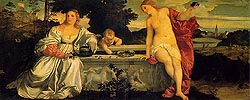 Sacred
and Profane Love is likewise identified as a bride by her garments. Even
today, brides are often identifiable by their dress --but otherwise a contemporary
woman's marital status is not apparent from her clothing. A medieval or Renaissance
woman's marriage, however, would be marked by the acquisition of a wardrobe
reflecting her change of status from maiden to matron and her transition from
her father's household to that of her husband. Part of the financial settlement
of a marriage typically earmarked funds for this worthy purpose. A woman's
clothing was thus specifically associated with matrimony in medieval and Renaissance
Italy, from the beginning of her marriage to its end, when her husband's kinsmen
were expected to provide her widow's weeds, while also possibly confiscating
what was left of her corredo, or trousseau, as part of the estate.
Sacred
and Profane Love is likewise identified as a bride by her garments. Even
today, brides are often identifiable by their dress --but otherwise a contemporary
woman's marital status is not apparent from her clothing. A medieval or Renaissance
woman's marriage, however, would be marked by the acquisition of a wardrobe
reflecting her change of status from maiden to matron and her transition from
her father's household to that of her husband. Part of the financial settlement
of a marriage typically earmarked funds for this worthy purpose. A woman's
clothing was thus specifically associated with matrimony in medieval and Renaissance
Italy, from the beginning of her marriage to its end, when her husband's kinsmen
were expected to provide her widow's weeds, while also possibly confiscating
what was left of her corredo, or trousseau, as part of the estate.
This bridal context explains one of the most idiosyncratic details of Titian's Venus of Urbino: the two servants who are either removing or replacing a gown in a cassone. That is to say, Venus' garment implies her corredo, and the cassone or rather the two cassone (these chests were always made in pairs) also refer to matrimony. Cassoni were traditionally commissioned by the bridegroom or his kinsmen on the occasion of his wedding and intended for the storage of clothing, particularly his wife's trousseau. Titian's twin cassoni are, then, purposeful signifiers, the furniture equivalent of the myrtle and bouquet of roses, plants that were then, and remain, familiar bridal attributes.
To these various references to marriage, we may add the dog that dozes at Venus' feet. Surely this is "Fido," unless Titian was being uncharacteristically perverse in all this matrimonial iconography. Such a dog can sleep peacefully because the person who has just entered is not an intruder; he is master of this household. And this particular dog suggests that the household in question was indeed that of the della Rovere, for the same spaniel (or a littermate) dozes on the table next to Eleonora Gonzaga della Rovere, Guidobaldo's mother, in Titian's portrait of 1536-38....
Despite these allusions to marriage, however, most scholars persist in labeling this Venus pornographic. Wilhelm Heinse, writing in 1785, may have inaugurated this critical tradition by describing her as "naughty" (schlimme), " a charming young Venetian girl between seventeen and eighteen years, with languorous glance." Fritz Saxl followed suit in his essay "Titian and Pietro Aretino," first published in 1935. Although Titian preserved the pose of the ancient Venus Pudica, Saxl wrote, the Venus of Urbino "might be called a travesty of the idea of the goddess' toilet." Writing as recently as 1991, Roberto Zapperi asserted that "the painting known today as the Venus of Urbino simply shows a nude woman lying on a bed, as her servants in the background attend to her clothes. In this everyday scene there is no reference to any known myth. But in itself this lack of mythical reference is no real objection to her identity as the goddess (Giorgione's Sleeping Venus also represents a scene unknown to classical authors), and in any case, Titian was never slavishly tied to ancient sources....
Given all the accoutrements of matrimony, why this stubborn modern reluctance to acknowledge Titian's protagonist as a bridal Venus? Why the reluctance to acknowledge her "world of social formation"? The answer lies in the figure of Venus herself. This woman seems far too sexy to be chaste.
Titian's
heroine lacks classical propriety, the passive demeanor expected (by modern
critics, at least) of an ancient goddess. His Venus, on the contrary, is alert
and powerful, more dominating than dominated by her unseen male beholder.
Renaissance people did not necessarily share the modern assumption that Venus
must be passive and diffident to retain her divinity, however, Botticelli's Venus, for example, remains entirely alert while Mars sleeps,
overcome by their recent sexual encounter. That these mythological beings
obey common laws of human biology does not in the least deprive them of their
classical identities. We recall that Botticelli's painting has been identified
as a marriage picture -- and that the composition Lucian's ekphrasis. The
Florentine Venus does not look at us but turns her eyes toward her beloved
--which is precisely the dynamic of Titian's Venus, though now the
object of the goddess' desire is before her, not within the picture.
Botticelli's Venus, for example, remains entirely alert while Mars sleeps,
overcome by their recent sexual encounter. That these mythological beings
obey common laws of human biology does not in the least deprive them of their
classical identities. We recall that Botticelli's painting has been identified
as a marriage picture -- and that the composition Lucian's ekphrasis. The
Florentine Venus does not look at us but turns her eyes toward her beloved
--which is precisely the dynamic of Titian's Venus, though now the
object of the goddess' desire is before her, not within the picture.
Venus' direct gaze has been characterized as an "unambiguous sexual invitation" by one wishful art historian. The invitation is germane to the matrimonial context, however, and in no way promiscuous. We may recall the forthright glance of "Profane Love," likewise addressed to her husband. Although modern viewers may be discomforted when caught in the act of looking --"caught in the act of voyeurism" -- Renaissance viewers would find such attention in keeping with the expectation, endorsed by Leon Battista Alberti, that a character would acknowledge beholders with a glance or a gesture. The modern critics' presumption of Venus' impropriety is a misconception that Edouard Manet's Olympia popularized.
Manet's protagonist is a prostitute --not a courtesan, as some critics have assumed Titian's Venus to be, but more the nineteenth-century equivalent of the Renaissance meretrice. The distinction among these categories were not mere niceties in Renaissance Venice. In general, a courtesan was distinguished from a meretrice (prostitute) or puttana (whore) by her class (or class pretensions), by her superior economic status, and by the social status and (limited) number of her lovers. As a concomitant of these social and "romantic" aspects of her position, a courtesan might also claim exemption from sumptuary laws concerning dress and legislation regarding where she might live.
Available to all comers and surrounded by explicit references to her trade, Olympia receives her next john --by implication, the beholder. But what of her Venetian predecessor? In a domestic setting and without Cupid or other explicitly mythological trappings, she may be a goddess or a mortal. If mortal, and even if a courtesan or mistress, she is nonetheless presented with clear indications of social status, and these are merely the trappings that serve to confirm what each woman reveals about herself in her expression and gestures: Olympia is hardened, cynical, blasée; Venus is confident, intelligent, alert. Whatever may have motivated Manet's alterations to Titian's composition --including the imposition of a new name-- the Frenchman's changes imply that he understood the Venetian woman to be a (culture) goddess who required not only modernization but profanation, not only emulation but denigration. Indeed, in his discussion of Manet's alterations in Titian's setting (notably the maid and the dog, now a frightened cat), /p. 149: Georges Bataille realized that "these changes are the outward signs of transition from one world to another. The world of mythology was nothing without the dignity which, forthwith, assimilated it to the world of theology, of which it was only an elegant variant, devoid of tragic import, but still imbued with poetic majesty." Bataille concludes that "Olympia is a woman and not a goddess." The Venus of Urbino, on the contrary, is at once a woman and a goddess.
Looking closer
to home in order to explain Venus' seeming lack of classical propriety, scholars
have also observed that the same model appears in Titian's La Bella,
described in Urbinate sources as the "woman in a blue dress". As
we recall, the painting was acquired by Duke Francesco Maria della Rovere
in 1536, that is, two years before the Venus was delivered to his son
and successor, Guidobaldo II.... The anonymous beauty's representation in
La Bella and in other works of the mid-1530s, such as the Vienna  Woman
in a Fur Coat, is fundamentally unrelated to the meaning of any of these
compositions. Rather, it is nothing more than testimory to her having been
employed by Titian as a model during those years.
Woman
in a Fur Coat, is fundamentally unrelated to the meaning of any of these
compositions. Rather, it is nothing more than testimory to her having been
employed by Titian as a model during those years.
The actual identities of Titian's models have been lost to history, though they may well have been prostitutes, given that such women often combined modeling with the oldest profession; and for all we know, Titian may have employed them in this sense as well. But even were that the case, it is not germane to their characterization in art. In Titian's art, the anonymous beauty becomes a mythic being, she becomes Sacred and Profane Love or Venus herself, or indeed she becomes the very embodiment of beauty. And in this process , her historical identity is taken from her: her own biography is irrelevant. What, then, is the significance of the reappearance of the model of La Bella, painted for Francesco Maria, in the Venus of Urbino, painted for his son Guidobaldo...?
/p. 150:For Giorgio Vasari, who saw Titian's painting in 1548 in the guardaroba, a room (or rooms) in the ducal apartments of Guidobaldo's palace at Pesaro, the subject was in fact a "young Venus, reclining, with flowers and certain fine draperies around [her], [which are] very beautiful and well finished.....
/p. 151: Certainly one might argue that any beautiful young woman could be labeled a Venus, the name being intended to compliment, not to identify. Yet there is no reason to think that Vasari used the name as a metaphor. Here, as throughout his Lives, he is matter-of-fact, not fanciful, and the reader can assume that Vasari meant literally what he wrote. To be sure, both Guidobaldo and Vasari are correct in describing Titian's subject: she is both a "nude woman" and "a young Venus" --the one being only a pithy yet accurate accound of the other. But as a fellow artist's description of Titian's composition, Vasari's title has particular authority. Yet in the absence of Cupid and other traditional mythological accoutrements, what made Vasari think that this woman is Venus? The answer is that for Vasari, as for other informed viewers, confirmation of her identity is found primarily in her type and in her pose --a pose adapted from Giorgione's Sleeping Venus [Dresden Venus].
More than twenty-five years separate Giorgione's invention from Titian's emendation. He changed the prototype into two conspicuous ways: Venus is now indoors, and she is awake. Outdoors, albeit furnished with cushions and sheets, Giorgione's Venus inhabits an amorous realm traditionally associated with love and lovemaking in medieval and Renaissance imagery, in part to evoke the mythic ideal, in part because only outside could actual lovers find the privacy that domestic spaces denied most people. Asleep, Giorgione's Venus seems demure in comparison with Titian's sentient, responsive heroine. As we have seen, these two well-known facts explain why critics believe in the divinity of the former while doubting the latter. The other reason is the presence of Cupid, painted over in 1843 and now visible only in X-radiography. Cupid and also the landscape were "finished by Titian," in words of a contemporary, Marcantonio Michiel. It is the inclusion of Titian's Cupid that confirms the divinity of Giorgione's woman: her pose and her nudity evoke antiquity without specifying identity.
Giorgione
conflated two or three ancient types in the Venus, combining the pudica
gesture associated with the goddess and the sleeping posture of classical
characters, who recline with one arm flung over the head. 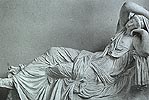 The
action of the right arm to indicate sleep was employed for numerous characters
in ancient or Renaissance art, but the gesture of the left was more restricted
in its use, perhaps because this gesture had a name and a history.
The
action of the right arm to indicate sleep was employed for numerous characters
in ancient or Renaissance art, but the gesture of the left was more restricted
in its use, perhaps because this gesture had a name and a history. ![]() As
readers of Lucian knew, the pose was invented by Praxiteles for the Aphrodite
of Knidos, which was a standing (or slightly bending) figure. Perhaps
surprised by a worshiper as she steps from her bath, the goddess conceals
herself as best she can, placing one hand over her pudenda. In later variations
on the Knidia,
As
readers of Lucian knew, the pose was invented by Praxiteles for the Aphrodite
of Knidos, which was a standing (or slightly bending) figure. Perhaps
surprised by a worshiper as she steps from her bath, the goddess conceals
herself as best she can, placing one hand over her pudenda. In later variations
on the Knidia, ![]() likewise
known to the Renaissance in numerous copies, the goddess places her other
arm across her breast: she is modest but at the same time provocative. Thus
Titian, like Giorgione and others before them, borrowed for painting a posture
famously conceived for sculpture, which makes the paragone of the arts a subtext
of the Venus of Urbino.
likewise
known to the Renaissance in numerous copies, the goddess places her other
arm across her breast: she is modest but at the same time provocative. Thus
Titian, like Giorgione and others before them, borrowed for painting a posture
famously conceived for sculpture, which makes the paragone of the arts a subtext
of the Venus of Urbino.
Since Praxiteles'
day, the pudica pose had been associated primarily, though not exclusively,
with Aphrodite. Respectable Roman matrons, for example, might be represented
in the guise of the goddess Venus --her pose, their faces-- just as their
Christian descendants might be portrayed with the characteristics of their
patron saints. In fact, any woman who is also intended to display modesty
or shame may be represented in the same pudica position. Eve, for example,
is thus ashamed when she is expelled from Paradise in 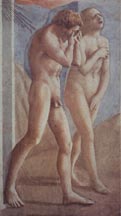 Masaccio's
Brancacci Chapel fresco and in
Masaccio's
Brancacci Chapel fresco and in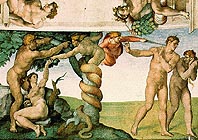 Michelangelo's variant on that composition for the Sistine Chapel.
Michelangelo's variant on that composition for the Sistine Chapel.
Titian adapted
the pudica pose for half-length figures, for example, the repentant (that
is, ashamed) ![]() Mary
Magdalen, now in the Pitti Palace....
Mary
Magdalen, now in the Pitti Palace....
/p.152: [I]n the Venus of Urbino, Titian departed from the venerable prototype in two significant ways. The first is straightforward: Venus does not cover her breast with her right arm but instead props herself up on pillows while clutching a bouquet of roses. The second variation, however, is problematic: unlike the ancient Venus pudica, she does not merely conceal, she carresses herself. The only precedent for this, or at any rate the most conspicuous one, is the Dresden Venus. And it is surely not coincidental that Manet also changed this detail, so that Olympia's hand bars access to herself.
Many observers are unwilling to acknowledge that Venus' gesture is an action, not a passive concealment, though both Giorgione and Titian clearly show the goddess' fingers curled, not extended, as in the ancient prototype and indeed as in other medieval and Renaissance depictions of the pudica, including the examples mentioned here. Others who may notice the gesture see it is confirmation of the woman's immodesty indicating lasciviousness and thereby negating the traditional meaning of the pudica pose --which, in a sense, it does. There is, however, another way to view this action, one that is consistent with sixteenth-century mentality.
Under most circumstances, this kind of self-caress was unequivocally condemned by medieval and Renaissance theologians and physicians. They did, however, endorse it in one particular situation, based on a mistaken view of conception: when a man withdrew from his wife before she achieved her own so-called emission, in effect, her orgasm. This medical opinion was motivated less by concern for a woman's sexual enjoyment (though some authors also stated that as a consideration) than by the conviction that the female's emission was the equivalent of the male's ejaculation, that is, the release of the seeds of life. From Galen's time onward, the woman's /p. 153: emission was generally believed essential for conception. Indeed most authorities agreed with Avicenna that "when she does not emit sperm a child is not made." Most authorities added, moreover, that she should do this at the same moment as her husband, simultaneous emission being another requirement for conception. To achieve this desideratum, female masturbation was deemed acceptable, and sometimes necessary. Indeed, fourteen of seventeen Renaissance theologians....allowed the female to reach orgasm through masturbation and thus, they believed, encourage gestation....
As we have seen, Titian took from Giorgione's Venus both the pose and the gesture. Now that Titian's goddess has awakened to behold her beloved directly, psychological tension established by the sexual demand explicit in her gaze has replaced the self-aborption of the Dresden Venus. The Venus of Urbino adds assertiveness to independence: fully sentient, cognizant, and self-aware, she reclines in a well-furnished, modern (sixteenth-century) bedroom and addresses her sexual power forthrightly to the beholder. Possibly for these psychological reasons --all consistent /p. 154: with Renaissance beliefs about the insatiable sexuality of women --some scholars have seen in her a pejorative implication of Guidobaldo's pithy label, "the nude woman": if she's not a virgin, she most be a whore. But the attributes of the goddess and the accoutrements of marriage, above all the cassoni, indicate more than what Guidobaldo said about the painting. Earlier cassoni were adorned on the outside with literary subjects; later examples, as in Titian's picture, with decorative motifs. But on the inside, under the lid, they might present a different, more private kind of imagery: figures making love, for example, or nude infants foretelling the fertility of the couple. In some cases, a nude woman --perhaps Venus herself-- reclines on this inner surface. Daniel Arasse has suggested that the Venus of Urbino may be understood as such a figure, released, as it were, from the concealment and displayed in the very bedroom that the cassoni themselves decorate.
The Venus of Urbino, like her prototype in Dresden, is a depiction of female sexuality, powerful, to be sure, but finding (in fact, demanding) appropriate fulfillment in marriage....
A beautiful woman's glance is one of the traditional weapons with which she enraptures, and maybe wounds, her lover, as Petrarch was wounded by Laura: but rarely is the Petrarchan glance so powerfully translated into imagery as in Titian's Venus. Her glance (like her gesture) is undeniably erotic, but whether it is also wanton depends on the object of her attention. The beholder, of course, cannot see him; indeed, sharing his space and vantage point, the beholder is effectively put in his place. Is he a courtesan's patron or a bride's husband? Surely her husband, because the Venus of Urbino is a marriage picture, unless its every clue, its every indicator of meaning, is purposefully misleading....
/p. 156: Fecundity, not sterile promiscuity, explains why Titian created his only domestic interior for the Venus of Urbino. The wall hangings, the masonry and column of the loggia, the cassoni, and the square patterns of the pavement provide modules to assert the measurability of this space, convincing us of the perspectival illusion. While seeming to insist on the verismilitude of his setting, however, Titian asserts not spatial unity but a disparity between the foreground and the background, even though we are invited to recognize the contextual relation between the two: a bed in the foreground, bedroom furnishings in the background. The vertical wall, draped with a green curtain, severs these spaces with surgical precision, and their apparent continuity is contradicted by the disparity of scale. (The standing maid, for example, measures slightly less than one-third the figure of Venus.) Titian reiterates this disjunction by vanquishing the vanishing point of his own perspectival construction with Venus' eyes. Following his spatial directives, we come to a point in the wall between the sill and the closed cassone and somewhere above Venus' navel --that is, we come to nowhere. The force of this spatial logic loses to the power of Venus' gaze, which is further honored by every other trick in Titian's Venetian book --by the manipulation of color and light, the direction of folds in the various fabrics, and the elimination of any other glance (even the dog's) as competition for our attention.
Titian's lighting undescores the spatial disjunction. The background is lighted from the left, so the standing maid casts her shadows to the right. In the foreground, Venus' feet also cast shadows to the right, but her red cushings are illuminated from the opposite direction. Their shadows create strong, almost parallel diagonals that lead the viewer's gaze to Venus', where it wished to go in any case. And these same diagonals join in space with others --the edges of the pillows and sheets-- to form a series of triangles or triangular sectionss, echoing the patterns of the drapery against the wall, all enframing Venus with their coloristic geometry.
The two geometric schemes, rectangular and triangular, meet where the edge of the foreground wall bisects the composition --the wall marks the center almost exactly-- where, as we /p. 157: have long since noticed, Venus conceals her own triangular form. This is not compositional vulgarity, but a means of honoring the female life force: Venus' body, or more precisely, that part of her body associated with procreation, is made both the pictorial center and the connection between Venus herself --that is, as an individual-- and her societal, familial role, encapsulated in the domestic background....
Spatial unity is illusory, then, as is its frequent concomitant in Renaissance art, temporal unity. Here one woman seems to have been captured in one passing moment, the transitory nature of which Titian underscored with such details as the roses escaping from Venus' bouquet, the maid's rolling up her sleeve, and so on. But temporal precision is deceptive in this seemingly unified setting. By her actions and demeanor, Venus presents not one moment but the entirety of her relationship to her beloved. The Venus of Urbino may be understood as a metaphor, Titian's image of the woman as wife, transcending narrative time in order to express eternal truths, in this case, the verities of the wifely (sexual) role as perceived by Renaissance people. Yet generative sex, though given pride of place, takes a secondary role to Venus' personality, which includes but is not subsumed by her sexuality. Her forceful gaze is assertive but not brazen. The eyes have it: Venus's eyes, which irresistibly hold our own, assert her character, her intellect, and her power to chose. What other critics have found to be whorish is, in Titian's lexicon, wifely, and his forthright presentation of female sexuality is (or was) given societal approbation in precisely this context....
Daniel Arasse, "The Venus of Urbino, or the Archetype of a Glance," reprinted in Titian's Venus of Urbino, pp.91-107: p. 97: ...the two spaces are interconnected. Each space is inconceivable in isolation. They are bound by a precise dialectic that attributes both contrasting and complementary values to each zone. A space of repose, containing the bed, is dominated by the horizontal; the chamber in the background is scanned by multiple verticals that echo and give rhythm to the actions of the figures. In the foreground, curves triumph (for example, contours of the woman's body and of the dog, folds of drapery on the bed, the tassel of the green fabric screen). In the background area with the greatchests, the perspectival patterns of the ground, the tapestries, and the window multiply the straight lines. To the nudity of the Venus's body is clearly opposed the theme of clothing, carried and prepared by the servants. As a corollary of this opposition, however, some of the particular circumstances of each area are recalled within the other. For example, the mattress rests on a straight line that Titian has taken care to make visible, whereas the longitudinal wall of the greatchests is curved, convex....
/p. 98: It is undeniable, therefore, that the structure of the Venus of Urbino depends on the placement of these two areas or sites in (artificial and dialectic) relation to each other. The perspective that designs the pavement of the chamber and unifies the canvas conceptually makes possible the elucidation of the principle of unity that inspires this disposition.
Titian rarely utilizes this kind of visible geometric perspective to construct a picture space. It is exceptional in his work that the perspectival elaboration be so manifest. In any case, one thing is certain: The Venus of Urbino is Titian's only painting of a nude woman in which geometric perspective is such a powerful element....These facts invite a closer consideration of the construction of the Venus of Urbino and its effect. Precisely in assigning a theoretical place to the glance of the viewer --a glance that is far from indifferent-- the perspective construction associates the two zones of the painting in a precise and unexpected way.
Titian's perspective places the horizon line of the composition (and therefore the theoretical gaze of the viewer) at the height of the head of the servant kneeling before the greatchest, which is also the height of Venus's left eye. The principal vanishing point is placed directly above Venus's (hidden) sex. This arrangement is very simple but too obvious not to have been calculated, and it leads to two consequences. First, the horizon line establishes an internal bond, latent but undeniable, between the position of the principal figure and the construction of the room located in the "background." Second, the viewer finds himself [sic] situated closest to Venus (this is the impression given by the body's emergence in the foreground), theoretically as though kneeling before her. This kneeling posture is suggested both by placing the bed against the floor in such a way that it seems to continue the plan of the ornamental tiling and by locating the (theoretical) glance of the beholder at the level of the nude's left eye. By dismantling the perspective composition, this analysis explains evidence that is concealed in the painting, thus clarifying Titian's conception: Standing before the painting, we are supposed to take the position that is assumed by the servant kneeling before the greatchest within the painting.
Michael Camille, The Medieval Art of Love: Objects and Subjects of Desire, 1998: p. 163: In Italy the art of love was paraded through the streets on the occasion of a marriage in the form of the two cassone chests usually purchased by the bridegroom, or by his family. These were used to transport his bride's dowry to the bedroom of the couple's house and then remained in the nuptial bedroom. In fifteenth-century Florence these large chests were often adorned with scenes of romances and mythology on their exteriors but their interior lids sometimes depicted the bridal pair, the bride totally naked and asleep in one, and her more modestly dressed husband awake and staring wistfully (at her?) in the other.
Cassone with the Battle of Trebizond, Florentine, 1460s.
Inner Lid of a Cassone with Cupid and Reclining Venus, c. 1440-45
Bridegroom painted on the inside lid of a cassone, Florence, c. 1450.
Gender Construction in the Renaissance
Titian's Venus of Urbino for contemporary Art Historians presents the archetypal example of the female nude in Renaissance culture. The male equivalent would be Michelangelo's David. A comparison of these two works reveals that the male and female nudes are not equal terms, but reveals the social construction of gender roles. Compare and contrast these two works. Consider how the contrasts between the two images seem "natural" within western culture. The clear distinction between the binary contrast of male and female still influences our sexual politics today. Try creating a table of binary oppositions beginning with male and female in contrasting these two works. What happens when we take these differences as being "natural"?
Art Home | ARTH Courses | ARTH 200 Assignments | ARTH 213 Assignments
